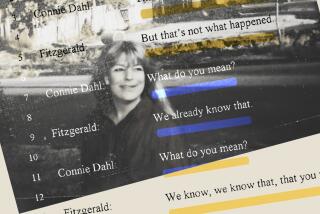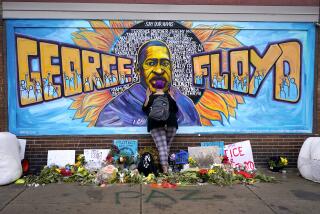Respect Is Rallying Cry of Dahmer Victims’ Kin : Murders: ‘No matter what his lifestyle, he was first a human being,’ a mother says. Blacks continue attack on what they see as a double standard.
- Share via
MILWAUKEE — The politicians all had had their say, the Baptist preacher’s thunder had shaken the tiny church to its rafters and thoughts were starting to drift toward home when Shirley Hughes stepped to the pulpit. Her eyes were red, her voice soft. A slight woman, she seemed to be weighed down by grief, barely able to stand without support.
But her words, plaintive and unadorned, expressed the cry for respect that had been the theme of that night--the theme, in fact, in Milwaukee’s black community for the last six months, since confessed serial killer Jeffrey Dahmer’s reign of terror came to an end.
Speaking of her son, Tony, one of the 17 men--most of them gay--Dahmer has admitted killing, Hughes said: “No matter what his life or lifestyle, he was first a human being.”
In sorrow and in rage, that sentiment has been expressed again and again since Dahmer’s arrest last July 22. Discovery of the shocking murders uncovered long-simmering tensions between the police and the black community. As Dahmer prepared to stand trial today, the emotions that gripped the city last summer and have since never receded far from the surface were boiling again.
“We’re going to have to go through what we did in July,” Annette Williams, a state representative from Milwaukee, told a weekend rally of support for the victim’s families. She added: “It’s going to be worse now, because of the details.”
The families of some of the murder victims have pleaded unsuccessfully to be informed of how their loved ones died before Dahmer’s trial begins.
As they have fought what they see as the dehumanization of those who died--Dahmer’s attorneys recently proposed that the victims be referred to in court by numbers instead of their names--so, too, have blacks here raged against a perceived double standard that they feel allowed Dahmer, a white man previously convicted of sex offenses, to kill 17 people--all but four of them black--without detection.
What galls them most is that on May 27th, two months before his arrest, the police visited Dahmer’s home, summoned by two black women who reported seeing Dahmer chasing through the night-time streets a boy who was naked and bleeding from the rectum.
The police officers disregarded the women’s impassioned complaints and believed Dahmer’s contention that the boy, a 14-year-old Laotian, was his 19-year-old drunken lover. They returned the youth, Konerak Sinthasomphone, to Dahmer’s apartment, where photographs of victims were strewn about and a decomposing corpse lay in the next room. Later, the officers joked about having to return to the station to get “deloused.”
“If a black man was chasing a white boy down the street, they would’ve shot him,” said Alderman Michael McGee, voicing an oft-heard sentiment.
Black and gay activists point to the incident, which left Dahmer free to murder the youth that night and to kill three more times in the next two months, as proof of police insensitivity.
To the more conspiracy-minded, the incident seemed proof of something else. Unsupported rumors persist here that Dahmer was part of a nationwide satanic network that preyed on blacks. The Rev. Leo Champion, one of those who subscribes to the conspiracy theory, denounced official investigations of the case as a cover-up.
Saying the issue in the case is one of civil rights more than of crime, Champion vowed that the community will continue to demand full disclosure. “We’re not going to be coerced by the police department,” he said in an interview. “We’re tired of the double standard.”
Dahmer’s knack for evading capture fueled the anger and distrust. A later investigation revealed that if the officers who questioned Dahmer in May had run a routine, computerized background check, they would have found out that he was on probation for a 1989 sexual assault on a 13-year-old boy--on Sinthasomphone’s brother, in fact. Supervision of Dahmer on probation had been so lax that he apparently operated with a free hand.
Geraldine Martin, the sister of one of murder victim Anthony Lee Sears, believes other dangerous criminals may also have been overlooked. “It has to be more than just him, for as long as he’s been getting through the system like that.” she said.
Dahmer, 31, has pleaded guilty but maintains he was insane, which has further infuriated victims’ survivors and others who fear he will be sent to a mental institution and perhaps eventually be released.
The jury will be asked to determine whether Dahmer was sane at the time he committed the 15 killings in Wisconsin to which he has confessed, which go back to January, 1988. In addition, he is charged with a 1978 murder in Ohio. Dahmer also confessed to killing another man in Wisconsin, but was not charged in that case because of a lack of evidence.
Dahmer reportedly has told authorities of trying to lobotomize his victims--to turn them into zombies by drilling holes in their heads--and of cannibalizing some of them. Police found seven human skulls in his apartment.
It is because of such details that defense attorneys suggested identifying the victims by numbers, a proposal that was rejected by Milwaukee County Circuit Judge L. C. Gram. Members of the victims’ families applauded that decision.
“My cousin Ernest was a human being,” said Luis Rios, a cousin of Ernest Miller, one of the slain men. “He wasn’t No. 15. He wasn’t No. 18. . . . Let them die with respect. Don’t let them die as mere numbers.”
Wisconsin Atty. Gen. James Doyle investigated the police role and decided not to file criminal charges, saying: “It is not against the law in Wisconsin to be insensitive to particular groups of people.” But Police Chief Philip Arreola fired the officers involved, on grounds that they had failed to follow department policy on following up complaints.
The firings infuriated many officers. In union balloting, 93% of the police force voted “no confidence” in Arreola and 97% said the officers should not have been discharged.
“It’s very upsetting when we know that (the officers) did nothing more than what the institution had trained them for,” said Bradley DeBraska, president of the Milwaukee Police Assn. He acknowledged that some anti-Arreola sentiment stemmed from his being the first chief hired from outside the city. “What the chief was attempting to do was deflect criticism off his own office by discharging the officers and holding them at fault.”
An appeal hearing for the two dismissed officers has been delayed until after Dahmer’s trial. The firing of a third, rookie officer was “held in abeyance” for a year to give him the opportunity to prove himself a satisfactory police officer.
Mayor John O. Norquist, responding to complaints about slow police response in some neighborhoods, racist and anti-homosexual attitudes and a general lack of respect shown by police officers--appointed a special committee to investigate police-community relations.
The committee’s report, released in October, called for a number of changes, among them swift action on a community-oriented policing plan, improved training of officers in the value of human diversity, improved citizen-complaint procedure and stepped-up civilian review of police practices.
Many here trace black antipathy toward the police to the 20-year reign of Police Chief Harold Breier, a tough-as-nails administrator under whose term relations with the black community deteriorated badly, in part because of several excessive-force cases.
Breier resigned in 1984, after the civilian Fire and Police Commission was given enhanced authority over the police.
“Quite frankly, when he left, the first objective of his replacement was to try to build bridges back with the inner city and try to re-establish working relations,” said N. Nicol Padway, a lawyer who chairs the Fire and Police Commission, which hires the police chief. “But with the relations that had existed, it’s been very difficult . . . . The Dahmer incident certainly didn’t help matters.”
More to Read
Sign up for Essential California
The most important California stories and recommendations in your inbox every morning.
You may occasionally receive promotional content from the Los Angeles Times.













